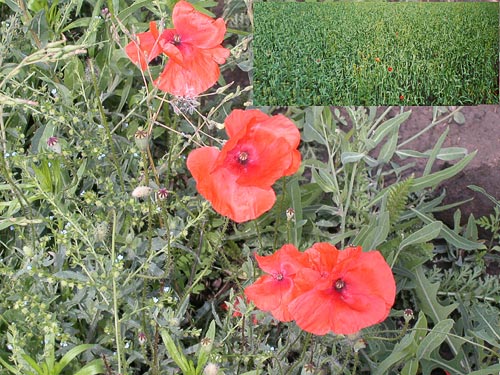Weeds
Papaver rhoeas L. - Common poppy.
Systematic position.
Family Papaveraceae Juss., genus Papaver L.Synonyms.
Field poppy, red poppy.Biological group.
Annual or faculatative biennial, germiniparous weed.Morphology and biology.
Root is cone-shaped. Stem is erect, with several stalks, with stiff projecting hairs, up to 60 cm in height. Cotyledons are long, slender, linear, prostrate. First 2-3 leaves are ovate, acuminate, entire, petiolate, hairless; next leaves are notched, bristly, initially rosette-shaped, later oblong-lanceolate, pinnate; upper leaves are usually tripartite, sessile. Flower is large, soft, single, with four bright red petals, often darkly spotted at base, nodding before blooming. Boll is almost spherical or wide obovate, 10-22 mm in length. Seed germination at depth not more than 1-1.5 cm. The weight of 1000 seeds is 0.1-0.2 g. One plant has up to 50,000 seeds. Seeds keep their germinating ability in soil for 5-8 years. Flowering in April-July.Distribution.
Scandinavia, Western and Southern Europe, Asia Minor, Iran, Northern Africa. South-western and southern regions of the former USSR, Western Siberia (seldom as adventive plant).Ecology.
Grows on primarily lime-rich, loamy to clayey soils. Light-dependent plant.Economic significance.
Infests summer grain crops; occurs in waste lands, kitchen gardens, orchards, along roads. Control measures include early plowing, chemical weeding, removing stubble after harvest.Reference citations:
Anonymous. 1996. Weeds on sugar beet. Berlin: Hoehst Schering AgrEvo GmbH. 242 pp. (In German, English, Russian, Ukrainian)Melnichuk O.S., Kovalivska G.M. 1972. Atlas of the most widespread weeds of the Ukraine. Kiev: Urozhay. 27-28 pp. (In Ukrainian)
Nikitin V.V. 1983. Weed plants of the USSR flora. Leningrad: Nauka. 194 p. (In Russian)
Shishkin, B.K., ed. 1937. Flora of the USSR. Moscow-Leningrad: AN SSSR. V. 7: 636-637. (In Russian)


